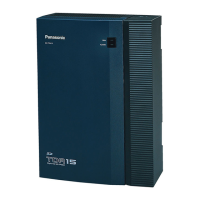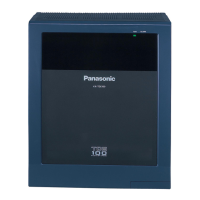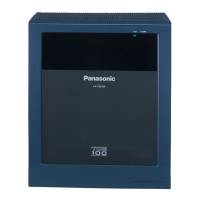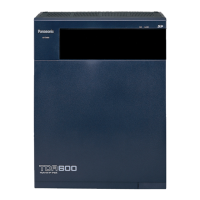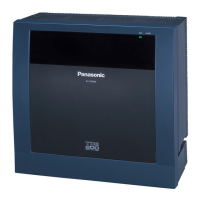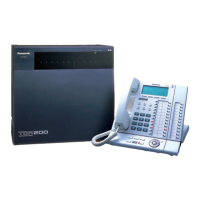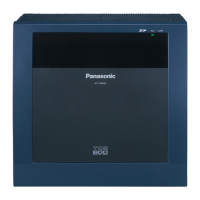Why did the background music start suddenly on my Panasonic KX-TD500 PBX?
- LLaura MillsSep 2, 2025
If the background music started suddenly, turn off the music.






Why did the background music start suddenly on my Panasonic KX-TD500 PBX?
If the background music started suddenly, turn off the music.
What to do if I hear a warning tone from my Panasonic PBX telephone?
If you hear a warning tone from your Panasonic PBX telephone, it means the handset was off-hook in an idle status for an extended period. Replace the handset.
Why is the line disconnected while talking to an outside party on my Panasonic PBX?
If the line is disconnected while talking to an outside party, the time limit may have expired. Consult your dealer to extend the time, if necessary.
What to do if extensions assigned for power failure operation do not operate on Panasonic Control Unit?
If extensions assigned for power failure operation aren't working during a power failure with your Panasonic Control Unit, it could be due to a DPT or APT being connected to the extension port, or an improper dialing mode (tone or pulse). Disconnect the DPT or APT and connect a single line telephone. Set the Tone / Pulse switch to the other position.
What to do if Speed Dialing or One-Touch Dialing does not function on Panasonic Control Unit?
If Speed Dialing or One-Touch Dialing isn't working on your Panasonic Control Unit, the programming might be incorrect. Enter the CO line access number (9, 801 through 848) into programming.
How to perform a reset operation on Panasonic Control Unit?
Press the Reset Button.
Why can't I make an outside call using One-Touch Dialling or speed dialling on my Panasonic PBX?
If you can't make an outside call using the One-Touch Dialling button or speed dialling on your Panasonic PBX, it's likely because a line access number was not stored. A line access number is required for outside calls.
Why can't I use my Panasonic KX-TD500 PBX telephone?
You may not be able to use your Panasonic PBX telephone for a couple of reasons. It could be locked, in which case you should unlock it. Alternatively, if your telephone is connected to an EXtra Device Port, system programming is required, so consult your dealer.
What to do if some Panasonic KX-TD500 features do not work?
If some features on your Panasonic PBX system aren't working, it could be because system management has restricted them; in that case, consult your System Manager. It's also possible that the feature numbers have changed, so confirm the revised number and try again.
What to do if I hear a reorder tone or see 'Restricted' displayed on my Panasonic KX-TD500 PBX phone?
If you hear a reorder tone or see 'Restricted' displayed on your Panasonic PBX phone, it could be due to a few reasons. Your telephone might be locked, so try unlocking it. Alternatively, toll restriction could be activated; if so, consult your System Manager or dealer. Lastly, it's possible that an account code is required.
| Digital Extensions | Yes |
|---|---|
| Analog Extensions | Yes |
| Caller ID Support | Yes |
| Automated Attendant | Yes |
| Direct Inward System Access (DISA) | Yes |
| Operating Temperature | 0°C to 40°C |
| Voice Mail Integration | Yes |
| Networking | Yes |
| VoIP Support | Yes (with optional cards) |
| Dimensions | 430 x 415 x 270 mm |
Identifies users and scope of the manual for KX-TD500 System, DPTs, DSS Consoles, and SLTs.
Outlines the manual's sections, covering DPT Overview, Station Programming, User Programming, etc.
Highlights key features of the KX-TD500 System, such as Automatic Callback Busy and Call Log.
Details the nine Panasonic Digital Proprietary Telephone (DPT) models and their specifications, including display and buttons.
Illustrates and labels the buttons and controls on various DPT models (KX-T7420, KX-T7425, etc.) for user reference.
Lists and describes the types of feature buttons (Fixed and Flexible) available on DPT models, indicating their availability per model.
Explains how users can program features individually by switching the telephone to Station Programming mode.
Provides a visual outline of how flexible buttons can be assigned to various functions via Station Programming.
Guides PT users on programming system features individually using the User Programming Password and telephone keys.
Details the procedure for setting the current date and time on the system, including year, month, day, and time format.
Provides essential information and considerations before operating the system, including telephone types and ISDN users.
Explains fundamental operations like making calls via Inter Office Calling and Outward Dialing, covering different trunk access methods.
Covers various features like Absent Message Capability, Account Code Entry, and Call Forwarding for PT and SLT users, detailing their operation.
Explains the purpose and connection requirements of the DSS Console with the KX-TD500 System and paired PT, listing available models.
Details how DSS buttons can be assigned to various functions like Account Button, Answer Button, and Conference Button via Station Programming.
Describes how to assign a Flexible DSS or PF button as an Account button for call accounting and billing purposes.
Provides English and French display examples for various system states, feature operations, and programming modes.
Lists default and additional digits for flexible and fixed feature numbers used in programming, including conflicts and additional digits.
Provides solutions for common problems like no sound in hands-free mode, unit not ringing, and display errors.
